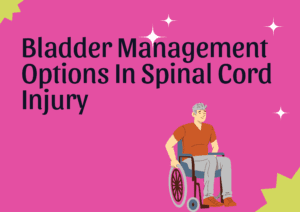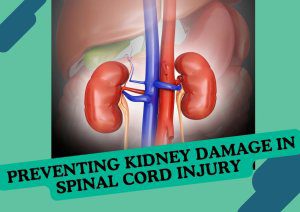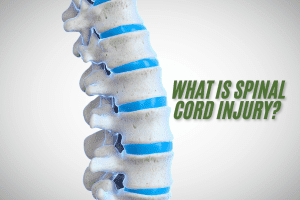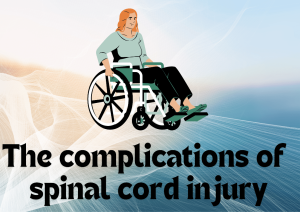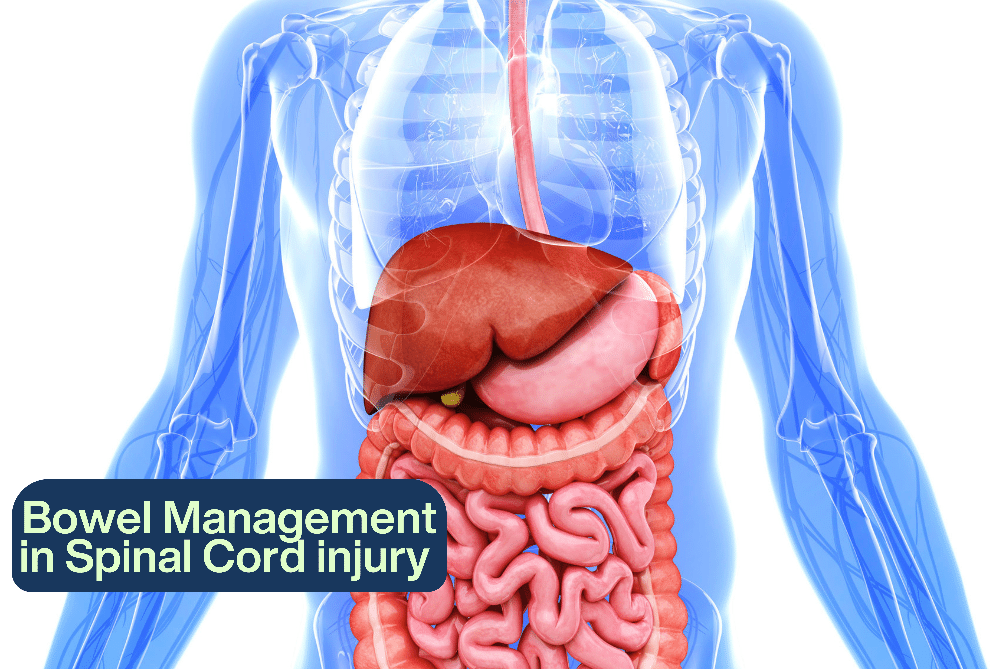
By Scihealthhub – November 8, 2024
In this comprehensive guide, we’ll walk you through effective bowel management strategies designed to enhance bowel function, boost overall health, and improve the quality of life for individuals living with spinal cord injury.
Spinal cord injuries can lead to significant bowel-related problems, such as constipation, unplanned bowel movements (incontinence), hemorrhoids, rectal bleeding, and discomfort (1). These issues don’t just impact physical health; they can also strain emotional well-being and social participation, making daily life more challenging.
Fortunately, with the right bowel management strategies, many of these issues can be managed effectively. This article will focus on practical, proven strategies to help individuals with spinal cord injury regain control and confidence in their bowel routines, promoting a more comfortable and active life.
Understanding Normal Bowel Function
It is important to understand how normal bowel function works to grasp how it is affected by spinal cord injury.
The bowel is part of the digestive system and consists of a muscular tube that extends from the stomach to the rectum and anus. The rectum is the last part of the bowel where stool is stored, while the anus is the terminal opening through which stool exits the body.
The bowel’s main functions are to break down the food and liquids we consume, absorb most of the useful nutrients into the bloodstream, and expel the leftover waste as stool.
Normal bowel function allows for the regular passage of soft, formed stools, which fill the rectum and are held there until the individual is ready to have a bowel movement – the act of releasing stool from the anus.
The frequency of bowel movements varies from person to person, but experts generally agree that a healthy range is from three times a day to three times a week.
Normal bowel function requires an effective flow of electrical signals back and forth between the brain and the bowel.
How Spinal Cord Injury Can Cause Problems with Bowel Function
Damage to the spinal cord in people with spinal cord injury can disrupt the transmission of electrical signals between the brain and the bowel, leading to abnormal bowel function in these individuals, a condition known medically as neurogenic bowel.
The nature and severity of symptoms in neurogenic bowel vary with the level of spinal damage. However, the most common symptoms are constipation, difficulty in defecation, and fecal incontinence.
Constipation results from the slow movement of food and stool in the bowel, which may cause infrequent bowel movements or hard stools.
Many people with spinal cord injury also experience difficulty with defecation due to the inability to use the abdominal and other muscles that facilitate bowel movement.
Fecal (bowel) incontinence, the inability to hold stool in the rectum, can also occur, causing stool to leak unexpectedly from the anus.
Other bowel problems encountered by individuals with spinal cord injury include rectal bleeding and hemorrhoids. The most common causes of rectal bleeding in these individuals are hemorrhoids and anal fissures (cuts or cracks around the anal opening). Repeated irritation and the passage of hard stool can increase the risk of anal fissures.
Risk factors for hemorrhoids in individuals with spinal cord injury include excessive laxative use, repeated digital stimulation of the rectum, and constipation.
What Is Bowel Management?
Bowel management refers to a variety of techniques that help people with neurogenic bowel dysfunction reduce constipation, ease defecation, and maintain continence.
Though often time-consuming, bowel management is crucial for improving bowel health and enhancing the overall quality of life in people with spinal cord injury.
Effective Bowel Management Strategies
If you have bowel problems following a spinal cord injury, your doctor will advise on the bowel management practices that are best for you.
However, we will highlight some key strategies that can help you manage your bowel and improve bowel health. They include:
- High-fiber diet
- Adequate fluid intake
- Regular routine for bowel emptying
- Use of oral and/or anal medication
- Abdominal massage
- Regular physical exercise
- Digital stimulation or manual evacuation
- Surgical treatments
High-Fiber Diet
Eating a high-fiber diet in adequate amounts daily is one way to improve bowel function and bowel health in people with neurogenic bowel.
Dietary fiber makes the stool bulkier, heavier, and softer, thereby improving bowel movements and reducing constipation. The bulking effect of dietary fiber also reduces the chance of diarrhea and incontinence.
Some studies show that high fiber intake may reduce the risk of colon cancer (2). Researchers have also demonstrated benefits of dietary fiber beyond bowel health, including lowering blood sugar and cholesterol levels (3).
To ensure adequate dietary fiber intake, include fiber-rich foods in most of your meals and snacks daily. Examples include fruits and vegetables, whole grains, nuts, and seeds.
Adequate Fluid Intake
Sufficient fluid intake is also an important component of bowel management, as it promotes soft stool, enhances the effect of dietary fiber, and reduces constipation.
Experts recommend a fluid intake of 2000-3000 ml per day (4).
Abdominal Massage
Abdominal massage is another way to improve bowel function and health in people with neurogenic bowel due to spinal cord injury.
Some research suggests that abdominal massage can speed up the movement of stool in the bowel, increase bowel movements, and reduce constipation and bloating (5).
To perform an abdominal massage:
- Lie on your back.
- Use your fingertips with firm pressure to massage around your belly in a pattern that resembles a large, upside-down “U” (the orientation of the large bowel).
- Make 8-10 small, clockwise circles starting at the lower right side of your belly, working up to below your ribs on the right, across the upper belly to the left, then down the left side, and finally toward the center.
- Aim for 8-10 circles as you work around your belly.
Repeat the massage for about 10 minutes. Studies vary, with durations between 10-40 minutes and frequency either daily or 1-2 times per week. Abdominal massage is cost-effective, has no side effects, and can be performed by the individual or a caregiver.
Regular Routine for Bowel Emptying
Establishing a consistent bowel emptying routine reduces the likelihood of incontinence and helps maintain cleanliness.
It’s best to plan bowel emptying about 20 minutes after a meal to take advantage of the gastro-colic reflex, which eases bowel evacuation. Experts suggest performing bowel programs on a toilet or commode, as an upright position allows gravity to assist with emptying.
A routine that allows you to empty your bowel every other day or three times per week is generally appropriate. Fewer sessions may increase the risk of chronic bowel distension (6).
However, if you experience stool incontinence due to a flaccid (loose) bowel, you may need to increase the frequency to once or twice daily. An effective bowel routine should not take longer than one hour.
Use of Oral and/or Anal Medication
This involves the use of laxatives, which stimulate the bowel, increase movement, and promote evacuation.
These medications can be taken by mouth (oral laxatives) or inserted into the anus (suppositories or mini enemas).
Oral laxatives are commonly needed for bowel management. Your doctor will advise if you need one as part of your routine. Oral laxatives are typically taken 8-12 hours before a planned bowel movement, so if you plan to empty your bowel in the morning, you may take the laxative the night before.
Anal medications, often combined with digital stimulation, are a cornerstone of bowel management for many individuals with spinal cord injury.
Here is a step-by-step approach to using a bisacodyl suppository or mini enema:
- Gather necessary materials, including the bisacodyl suppository or mini enema, gloves, water-based lubricant (e.g., K-Y jelly), toilet paper, etc. Bisacodyl suppositories are usually stored in a refrigerator to keep them firm for easy insertion. If a whole suppository feels too strong, you can cut it in half.
- Move into position, preferably on a commode or toilet, where you’ll be seated upright so gravity can assist with bowel evacuation. If sitting is not possible, lie on your bed and turn to your left side.
- Wash your hands and put on gloves.
- With a gloved hand, insert the lubricated suppository or mini enema as high as possible into the rectum, ensuring it contacts the rectal wall for maximum effectiveness. If placed in the center of stool, it may not effectively stimulate bowel movement.
- Wait for 20-30 minutes for the mini enema or suppository to take effect. Often, the passage of gas or stool signals the onset of bowel movements, indicating it’s time to proceed with digital stimulation or manual evacuation.
You may wish to use the 20-30 minute waiting period to empty your bladder.
Digital Stimulation and Manual Evacuation
To ensure you expel as much stool as possible, digital stimulation and manual evacuation may be necessary.
Digital stimulation helps to trigger more and stronger bowel movements. Follow the steps below to perform digital stimulation:
- Gently insert your gloved and lubricated finger into your rectum.
- Rotate your finger in a circular pattern for 10 to 20 seconds, keeping it in contact with the rectal wall.
- Repeat the digital stimulation every 5-10 minutes and continue until you have expelled the last set of stool.
In addition to digital stimulation, other actions that may promote bowel movements include:
- Abdominal massage – Firmly rub your abdomen in a clockwise direction.
- Valsalva maneuver – A technique to increase abdominal pressure by trying to breathe out forcefully against a closed airway.
- Body movements – Leaning forward, performing body push-ups, and moving side-to-side.
- Tightening and releasing abdominal muscles.
Surgery
Surgery is reserved for rare cases of severe neurogenic bowel that do not respond to the non-surgical measures mentioned above. The most common surgical option for bowel management is a colostomy, a procedure that brings one end of the large bowel out through the abdominal wall.
Before undergoing any surgical treatment, your doctor will inform you of the benefits, risks, and possible complications.
In conclusion, neurogenic bowel is one of the major challenges experienced by many people with spinal cord injury. An appropriate bowel management program is essential for bowel health and an improved quality of life.
We hope you liked this article and found it helpful. Please follow us on Facebook and Twitter, and feel free to leave your comments or questions.
You may also like to read 10 Tips for Maintaining Physical Health in Spinal Cord injury.

